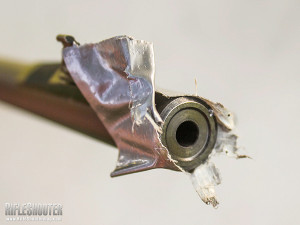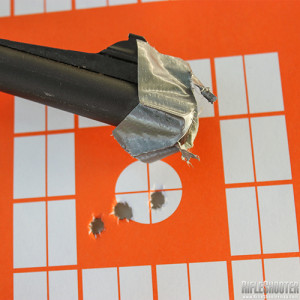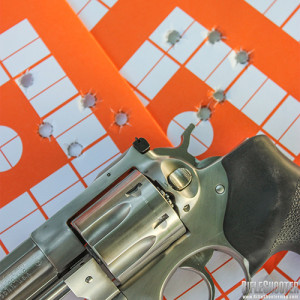Years ago I started doing this in case of tripping and falling while walking through the woods, or dropping a rifle muzzle down etc. and having mud or other obstruction getting into the barrel. It has always given me peace of mind and is easier than carrying a cleaning rod and patches etc into the field. This holds especially TRUE if carrying a Lever Action as it can be inconvenient to have to remove the lever, and take a chance on losing a small screw when removing the lever or losing the ejector when removing the bolt etc.
HERE is a link to proper cleaning of the Marlin Series Lever Action rifles:
http://www.marlinowners.com/forum/how-disassemble-clean/20184-disassembly-assembly-1895-pics.html
My own tests were always done at 100 yards with and without the electrical tape. No measurable difference in accuracy was ever encountered. I have shot a number of deer with the muzzle of whatever rifle or shotgun or muzzle loader I happened to be carrying at the time.
It was an EXCELLENT ARTICLE, as every year I still run into hunters that are skeptical of using this approach as it goes against the grain of thinking that somehow they are plugging up their own barrel. As the article points out, the escaping pressure from touching off a round blows the tape off the muzzle before the bullet encounters it anyway.
In any event, here is a link to the article and glad someone decided to do a 3 part test on this to put the issue to bed once and for all.
Have a great hunting season and may the buck of your dreams dross your path.
Dan
http://www.rifleshootermag.com/accuracy-tests/fact-fiction-tale-tape/
EXCERPT:
Fact or Fiction: The Tale of the Tape
21 Rumor has it that duct tape over the muzzle of a firearm can prevent mud and debris from obstructing your barrel and doesn’t affect accuracy. Is that true?
Rumor has it that duct tape over the muzzle of a firearm can prevent mud and debris from obstructing your barrel and doesn’t affect accuracy. Is that true?
We might not remember the first time we hear a rumor, but in this case I remember it clearly. Long ago, a group of American outdoor writers tagged along with some serious boar and sambar hunters in Australia. On the hunt, every rifle had a ring of duct tape around the muzzle, purportedly to prevent mud from clogging the bore and creating a dangerous situation.I thought it was a waste of valuable duct tape at best. I believed tape over the muzzle wouldn’t affect accuracy enough to cause you to miss a 300 pound pig at 40 yards, but I had my doubts that the tape had zero effect on the accuracy of a sub-MOA gun at 100 yards or more.
Serious shooters worry about barrel vibration, bedding, barrel heating and a host of other details that can rob accuracy. A wrinkled, gooey, silver blob of duct tape blocking the exit door of your rifle seemed enough to make a serious rifle crank’s knee buckle.
When the opportunity arose to provide ideas for the new “Fact or Fiction” series, this was the first theory I wanted to test. Initially, I planned to include only a .223 in the test, but I thought it should be expanded. I doubted that using a larger caliber rifle would change the results, but it was important to be sure. In addition, I tested a revolver as well to see if it reacted the same way as the long guns.
The test was going to mimic standard accuracy tests at RifleShooter and Handguns magazines, which meant three 3-shot groups at 100 yards for the rifles and four 5-shot groups at 25 yards for the handgun. The first test would be an average grouping with no tape on the muzzle for a baseline accuracy test to compare with the duct tape results. The second test involved shooting the rifle or handgun with fresh duct tape applied to the muzzle for every shot, and the last test required me to fire the first shot with tape on the muzzle and to fire the remaining shots without adding more tape, which simulates real field conditions since the tape would be blocking the muzzle for the first shot and would be gone for the subsequent follow-up shots.
For the revolver test, I used a Ruger GP100 with a six-inch barrel. I used two guns for the rifle test: a Remington 700 .223 that is extremely accurate and a Howa chambered in .375 Ruger. In retrospect, choosing to shoot a .375 Ruger in a test that required me to put almost 30 rounds downrange was not the brightest decision I’ve made, but comparing a .223 and .375 helped examine whether or not caliber or energy affected the tape myth.

Placing duct tape over the muzzle has little effect on a rifle’s accuracy. Duct tape is tough, but it can’t withstand the tremendous air pressure within the barrel and it doesn’t noticeably affect bullet placement.
The .223 printed three tight little groups at 100 yards that averaged .94 inches. When a rifle shoots that well, it’s hard to slap a piece of gooey duct tape over the muzzle, but I did, after the barrel cooled between shots. I’d like to say that allowing the barrel to cool completely was a result of the strict consistency found in all my range tests, but it was nothing so poignant or impressive.
In truth, like a dummy, I slapped the first piece of duct tape on the barrel while it was still hot, and the adhesive goop on the duct tape seemed to melt into the exterior metal. After an impromptu cleaning session to be sure that the gray, gooey film would indeed come off my rifle, I began waiting for the barrel to cool completely between shots. When you’re shooting three groups of four shots with a pistol and three groups of three with two different rifles, that’s a lot of barrel cooling time.
The results with the .223 were extremely unimpressive. With or without tape, the rifle grouped around an inch. The overall average with fresh tape for all three shots was exactly an inch, and when tape was applied for the first shot the average was .95 inches at 100 yards — meaning duct tape over the muzzle has very, very little effect on accuracy.
Or, in some cases, it makes the rifle more accurate. That’s not completely true, but in the two tests with the booming .375 Ruger, the rifle was actually more accurate with the duct tape in place. Without the tape, the howling Howa averaged 1.83 inch groups, about as expected. The average group with tape on all three shots was 1.76 inches, and with tape on the muzzle for the first shot it averaged 1.66 inches.
The revolver test was last, and the resulting groups were similarly average; at 25 yards it grouped 2.28 inches without tape, 2.39 inches with tape on all three shots, and 2.11 inches with tape on the first shot.

Duct tape has little or no effect on a revolver’s accuracy. At 25 yards, this revolver grouped 2.28 inches without tape and 2.39 inches with tape.
In essence, duct tape doesn’t affect accuracy at all. The idea that the bullet strikes the tape and is somehow sent off-target is completely false, in large part because the tape is long gone before the bullet reaches the muzzle. With tape on the muzzle and a cartridge in the chamber, the air in the barrel is trapped. When the bullet begins traveling down the bore, the air pressure increases. Duct tape is tough, but it isn’t going to withstand thousands of pounds of pneumatic pressure.
So, the rumor about tape over the muzzle isn’t a rumor at all — the accuracy remains consistent, and you don’t have to worry about firing a rifle with a plugged barrel and injuring or killing yourself or others. But while the tape doesn’t negatively affect your rifle’s accuracy, it can affect your rifle’s finish, especially if you don’t remove that nasty adhesive right away.

No comments:
Post a Comment